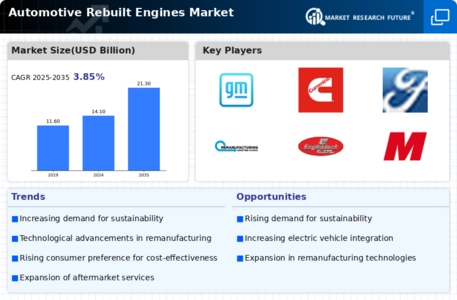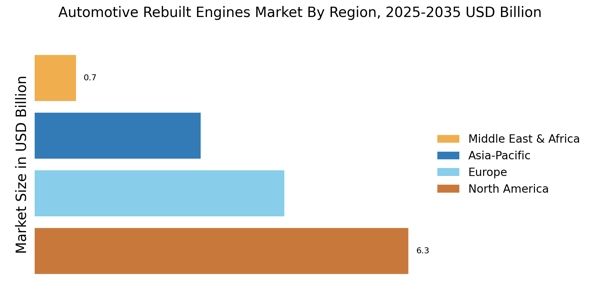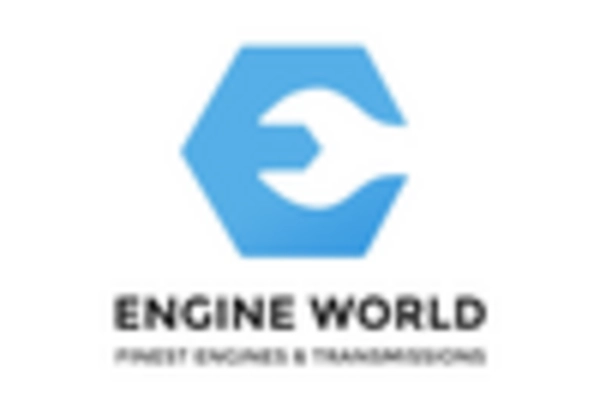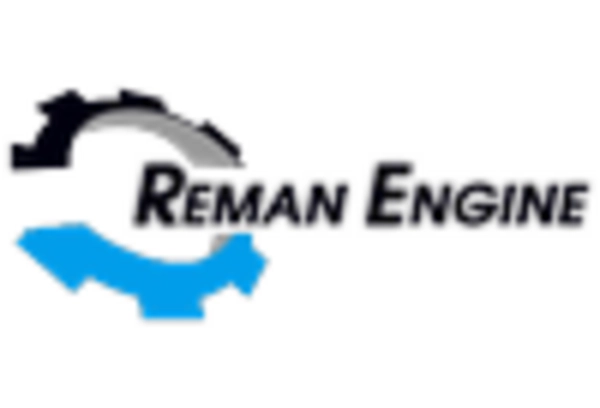Rising Popularity of DIY Vehicle Maintenance
The Automotive Rebuilt Engines Market is benefiting from the increasing trend of do-it-yourself (DIY) vehicle maintenance among consumers. As more individuals take an interest in maintaining their vehicles independently, the demand for rebuilt engines is likely to rise. DIY enthusiasts often seek cost-effective solutions, and rebuilt engines provide an attractive option for those looking to replace or upgrade their vehicle's engine without incurring the high costs associated with new engines. This trend is further supported by the availability of online resources and communities that encourage DIY maintenance. Consequently, the Automotive Rebuilt Engines Market is poised to capitalize on this growing segment of the market.
Technological Innovations in Engine Rebuilding
Technological advancements are playing a pivotal role in shaping the Automotive Rebuilt Engines Market. Innovations in engine rebuilding techniques, such as precision machining and advanced diagnostic tools, have enhanced the quality and reliability of rebuilt engines. These improvements not only increase the performance of rebuilt engines but also extend their lifespan, making them a more appealing option for consumers. Additionally, the integration of modern technologies, such as computer-aided design and 3D printing, is revolutionizing the rebuilding process. As these technologies become more prevalent, the Automotive Rebuilt Engines Market is expected to witness a rise in consumer confidence and demand for high-quality rebuilt engines.
Expansion of E-commerce Platforms for Engine Sales
The Automotive Rebuilt Engines Market is experiencing a transformation due to the expansion of e-commerce platforms dedicated to engine sales. As consumers increasingly turn to online shopping for automotive parts, the accessibility of rebuilt engines through these platforms is enhancing market reach. E-commerce allows consumers to compare prices, read reviews, and access a wider variety of rebuilt engines than traditional retail channels. This shift is particularly beneficial for smaller businesses that may not have the resources for extensive physical storefronts. As online sales continue to grow, the Automotive Rebuilt Engines Market is likely to see increased competition and innovation, ultimately benefiting consumers.
Increasing Demand for Affordable Vehicle Solutions
The Automotive Rebuilt Engines Market is experiencing a surge in demand for cost-effective vehicle solutions. As consumers seek to maintain their vehicles without incurring the high costs associated with new engine purchases, rebuilt engines present a viable alternative. This trend is particularly pronounced in regions where economic constraints limit consumer spending on new vehicles. According to recent data, the market for rebuilt engines is projected to grow at a compound annual growth rate of approximately 5% over the next few years. This growth is driven by the increasing number of older vehicles on the road, which often require engine replacements. Consequently, the Automotive Rebuilt Engines Market is positioned to benefit from this shift towards more economical vehicle maintenance options.
Environmental Regulations and Sustainability Initiatives
The Automotive Rebuilt Engines Market is significantly influenced by the growing emphasis on environmental sustainability. Stricter emissions regulations and a societal shift towards eco-friendly practices are prompting consumers and manufacturers alike to consider rebuilt engines as a more sustainable option. Rebuilt engines typically produce fewer emissions compared to their new counterparts, aligning with global efforts to reduce carbon footprints. Furthermore, the recycling of engine components contributes to resource conservation, making rebuilt engines an attractive choice for environmentally conscious consumers. As governments continue to implement policies aimed at reducing vehicular emissions, the Automotive Rebuilt Engines Market is likely to see increased demand for rebuilt engines as a sustainable alternative.


















Leave a Comment